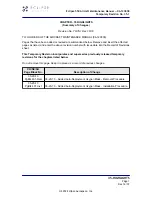
Pluto II
9
Initiation
:
Weight shift and smoothly pull on one brake so the glider goes from a
normal 360-degree turn into a steep turn and from there into a spiral dive. Once
established in the spiral the descent rate and bank angle can be controlled with
weight shift and the releasing or pulling of inner brake.
Recovery
: The Pluto II recovers from a spiral spontaneously as soon as the brakes are
released and weight shift returns to neutral. To exit allow the spiral to slow for a turn
or two by slowly releasing the brake. Once the glider starts to exit the spiral, control
your descent rate and bank angle with weight shift and the outer or inner brake to
prevent any strong climbs out of spiral. Do not overapply the outer brake since there
are very strong forces with very harsh reactions possible. Always finish a spiral dive at a
safe altitude.
Important notice! A pilot who is dehydrated and/or not accustomed to spiralling
can lose consciousness during a steep spiral dive!
As with all types of aircraft, we advise that you allow the Pluto II to exit from the spiral
dive in a controlled manner. You should take care to use only moderate spirals so as
not to put unnecessary load on you and your lines.
C. Flying in turbulent conditions
Deflations can occur when flying in turbulence but in most situations the Pluto II will
stabilise without pilot input. Flying with a little brake applied equally will help to
prevent deflations and allow you to experience more direct feedback.
Active flying will help avoid deflations. The aim is to keep the glider above your head
in all situations by responding correctly to the glider's movements by using the brakes
and weight shift.
It is important these manoeuvres are initially practiced under qualified supervision and
preferably during a safety training course.
Asymmetric collapse
The Pluto II will normally re-inflate after an asymmetric collapse without input from
the pilot, but the wing may turn slightly towards the collapsed side. You should always
maintain course and direction by weight-shifting away from the collapsed side. This
can be reinforced by applying a small amount of brake on the opposite side to the
deflation. If the collapse stays in, the collapsed side can be re-inflated by pumping the
brake on the collapsed side in a firm and smooth manner.
If you experience a big collapse while accelerated, the canopy will fall behind you due
to the difference in inertia between you and the canopy. You must wait until you
pendulum back under the canopy before dealing with the deflation. Reacting too early





































